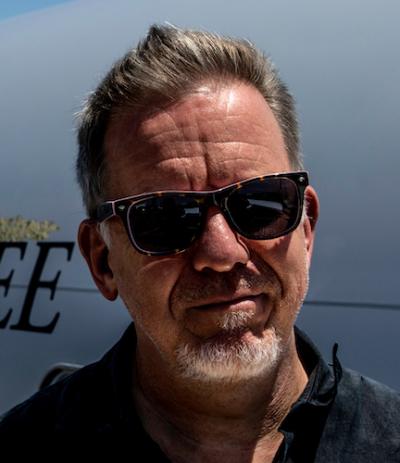Starting back in 1982, and including such mega tours as Zoo TV in 1992-93, PopMart in 1997-98, Elevation in 2001, and U2 360° in 2009, Willie Williams—and his Treatment Studio—has been the designer and creative spirit behind the look for U2, collaborating with the band as their visual territory continued to expand. Now, 40 years later, their new show, U2:UV Achtung Baby Live has taken Vegas and the world by storm, opening the massive performance venue at Sphere, and creating a media storm in the process. Massive immersive video, a round stage inspired by Brian Eno’s LED turntable, stunning visuals, dramatic lighting, and an incredible performance by one of the most venerable rock bands in the business. Let’s take a moment to chat with Williams and find out what went into the heart and soul of this mega project.
Live Design: When did you and U2 know you were opening Sphere and did it seem like a daunting project?
Willie Williams: The idea first came up about two years ago and initially I wasn’t terribly keen. The thought of spending an extended period of time in Las Vegas wasn’t overly enticing but more pragmatically I was concerned about conceiving a show based on a piece of equipment, rather than the other way round. All the image-based shows I’ve made have started with an idea, out of which the video surface is borne, rather than beginning with hardware. I’m forever telling students that you can’t start a design with an equipment list, and this seemed like it might be a huge version of that.
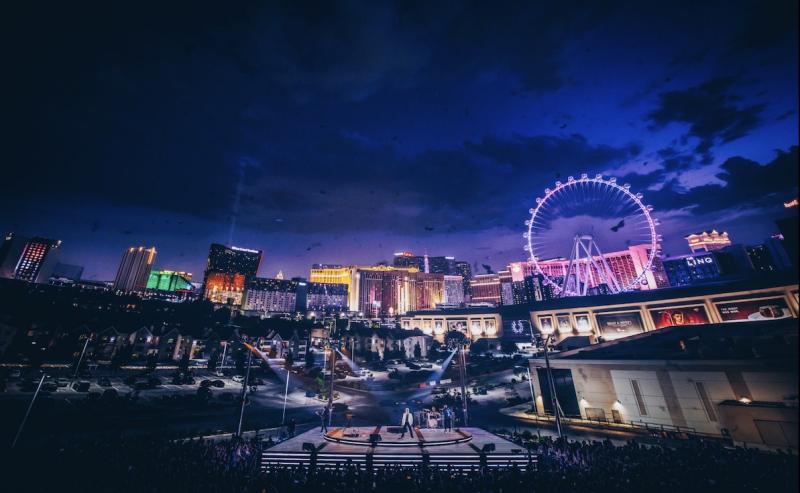
LD: How did you approach the design given the huge volume of the space and acres of video screen—did it seem like a huge fabulous playground for your creativity...
WW: From the very first conversations with the band, I was at pains to point out that we were making an ocean liner not a dinghy; that once the design process got up to speed it wouldn’t be possible to change course quickly. Not being their first big-video rodeo, they fully understood this and remained engaged throughout the design process.
As always, we began with a think tank about what kind of show we might find interesting. U2’s extended creative team likes to get together for a weekend and download everything we’ve each been thinking about since the last time we made a show. In practical terms, Es Devlin, Ric Lipson of Stufish, and I make up a triumvirate to lead the charge, developing storyboards and steering the process over the following weeks and months. Of course, with this project, not only did we have to imagine an entirely new kind of show but we had to imagine the venue it would be performed in.
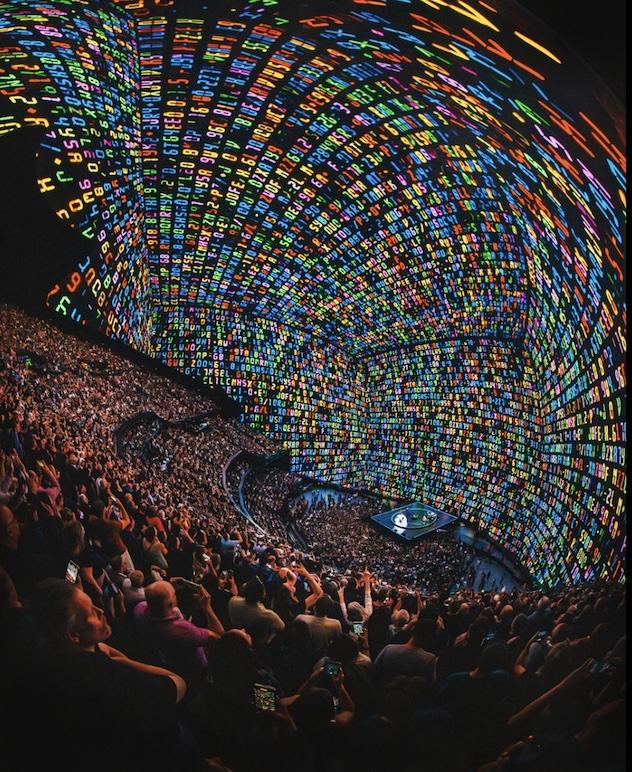
LD: What did the band want to achieve with the design of the show?
WW: The brief was wide open but we knew we wanted to create an all-encompassing show with a coherent through-line. We felt it could could also function as a kind of group show for digital artists, some of whom we worked with directly, others we reference more obliquely. Bono had a strong, early idea that at some point during the show we should ‘make the building disappear’ to reveal exactly what was outside. He was also keen to involve the work of an Irish artist, John Gerrard, who makes digital landscapes that include a flag and relate to eco-issues.
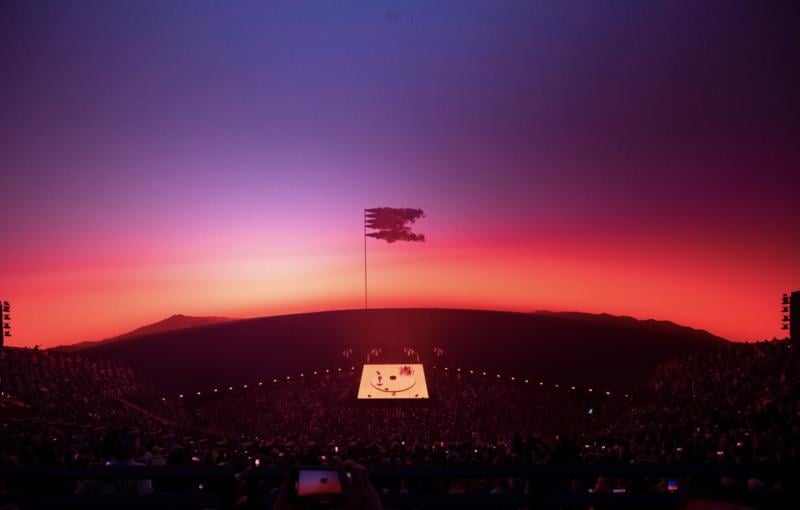
LD: How did you go about the video design, in terms of content... and in terms of design, workflow, process.. who were your technical collaborators and vendors?
WW: Treatment Studio took on the monumental task of producing all the video content for the show. The majority of the video sequences in the show are directed by me and produced in-house by the Treatment team of video creatives, along with work produced in tandem with fine artists and directors. Marco Brambilla, Es Devlin, and John Gerrard contributed pieces based on existing works of their own, although everything had to be remade from scratch, given the massive resolution of the screen. For Bono’s ‘disappearing building’ piece we commissioned Industrial Light & Magic to create a CGI sequence which proved to be an absolute joy.
Often, a huge part of the task was rationalizing the render times. Initially some sequences were calculating render times of up to 15 minutes per frame (roughly a fortnight of rendering per minute of footage) which was clearly untenable. Brandon Kraemer was Treatment’s technical lead, working with Smasher Desmedt, disguise, and Fuse to create a viable workflow for the artists.
VR proved very useful in designing the show as it was often the only option available to view what we were making. VR resolution is still very low, so it wasn’t about image quality, but it was frequently helpful in deciding how big something needed to be or how fast something should move. It was also great to be able to view elements from all over the building without tramping up and down stairs.
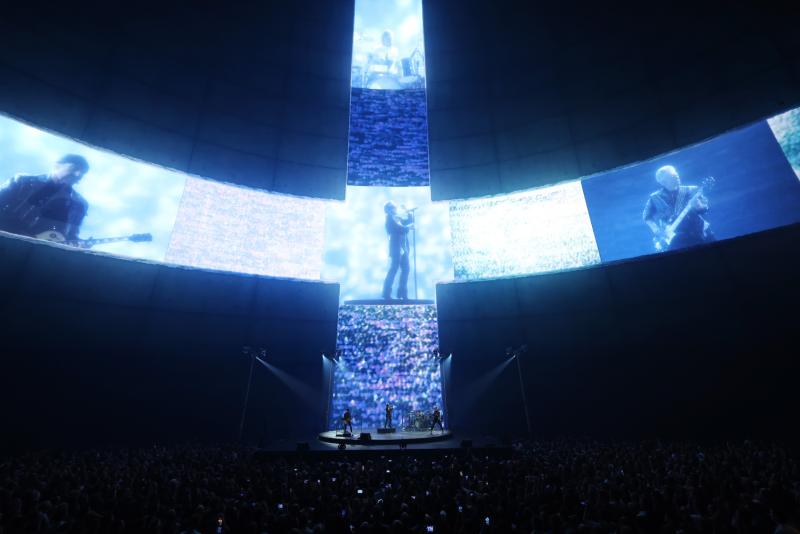
LD: What about the lighting, how did you design that to even be in the same space with the video—what were the goals of the lighting.. how did you collaborate with lighting director Alex Murphy?
WW: Ah, the lighting. Sphere has a house rig of about 150 fixtures but their usefulness is extremely limited. For the most part the lamps are spread along the balcony rails which means the only thing they can do is provide a flat front light or point at the screen, neither of which is particularly helpful. Finding locations for any rear lighting at all in this building is a near-impossibility without hanging trusses in front of the screen which would be a tad self-defeating, so it really was a puzzle. With most of my shows, I usually find I’ve left myself very few options to place lighting fixtures, but this really took the challenge to another level. After many explorations (including scissor lifts, louvered screen panels and arches) I settled on the four articulating chrome lamp posts. When standing upright, the chrome finish helps them disappear into the video picture, but they can also ‘bow’ out of the way if we really want a clean picture.
I wanted the lampposts to be minimal in thickness which affected the payload, so we found ourselves attempting to reinvent live entertainment with a sum total of twelve back lights. I’ve always thought of myself as a minimalist who ran away with himself, but this is a slim package even by my standards.
iMag and lighting for camera were very major concerns of the band. I’m the same age as the band members and I certainly wouldn’t want giant, hi-res close-ups of my own face circulating the planet, so I sympathized with their hesitancy. Also, given that performers these days are filmed by their audience for the entirety of the show and from every conceivable angle, I was aware that this was something I needed to take seriously.
A wise, early decision was just to bring everybody. In the lighting department I reunited Alex Murphy and Ethan Weber from their glory days on the U2360 tour and added Matt Beecher who was my lighting director for the Broadway run of Bono’s Surrender show earlier this year. To bring the camera discussion into the frame early, I invited Allen Branton and Felix Peralta to come for the whole of the build and rehearsal period, so we could feel our way in incrementally. Smasher is directing the cameras and he made the brilliant decision to spend his budget on fewer cameras of higher quality (digital movie cameras, essentially) so we gave ourselves every chance to succeed. Smasher, Allen, and I go all the way back to the Zoo TV Live From Sydney shoot, so know each other inside out, having a great deal of trust and respect for each other and for the process. I’m delighted with the result and the band members are too. Given the parameters it’s quite remarkable how well the camera images have turned out.
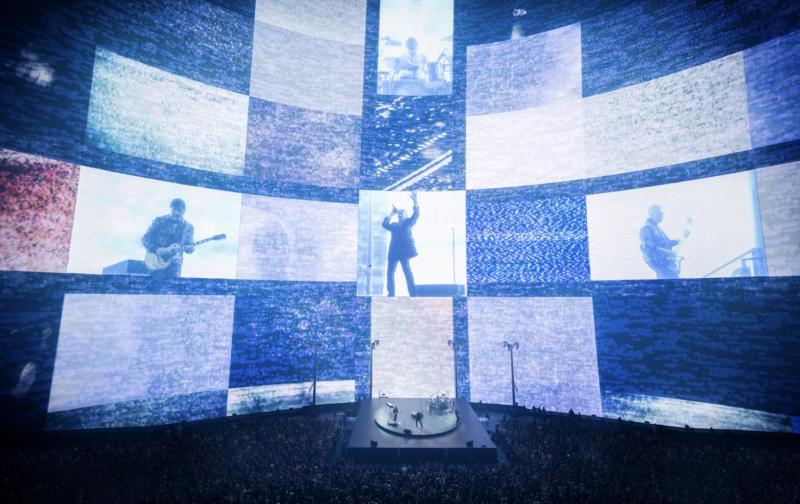
LD: What were the biggest challenges on this project - I can only imagine...
WW: The biggest technical challenge was creating a playback system suited to running a live show. The in-house system by 7thSense is designed to show movies at extremely high resolution, but it isn’t a timeline-based system of the kind typically used in concert touring. Headed by Brandon Kraemer from Treatment, in tandem with Smasher, Disguise & Fuse, we created a system that harnesses together around twenty three disguise g X3 media servers. This provides the required resolution (we are mostly running 12K x 12K) but also affords us all of the camera integration and image manipulation that we are used to having on a tour. That feat alone is worthy of a Nobel prize.
Making any show is the confluence of art, science and diplomacy and on this project, diplomacy was by far the biggest hurdle. Not only were we working in an unfinished building but we also had to work in tandem with Darren Aronofsky and team who were making the immersive movie that is the resident in-house attraction. The double whammy of trying to do production rehearsals around building works and also having to share the space with another project was (please god) a once-in-a-lifetime challenge that frequently felt like attempting a three-legged obstacle course up Mount Everest. Happily we had Jake Berry at the helm who, should he ever lose his love of show production, could now easily get himself a gig with the Diplomatic Corps.
Where we eventually got to with the show is quite remarkable though, and the global response has taken us all by surprise. It’s such an odd thing - every time we make a new show everything goes into it. Sometimes a show might get good reviews but doesn’t really attract much attention outside the immediate bubble of touring; this time though, the entire Western world seems to have taken note of what we’ve been up to. I’m absolutely delighted for U2. Not only is this show getting rave reviews but their whole legacy of having been the people who have pushed conceptual and technological boundaries for decades seems finally to be being acknowledged. It’s extremely gratifying to be part of that.
Join Live Design online for a free "Live Chat With Willie Williams, U2 Visual Guru" at 11am ET on December 12, 2023. Register Here.
